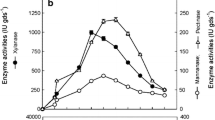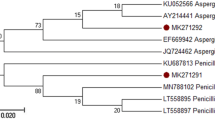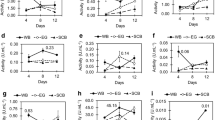Abstract
Fungal strains were screened for lipase producing activities and 10 strains were classified as good producers. Aspergillus sp., Fusarium sp., and Penicillium sp. exhibited the highest activities when fermented in wheat bran (WB) and soybean bran (SB). No fungal growth was observed using sugarcane bagasse (CB). An experimental design was applied to incorporate CB into the fermentation process for lipase production by Aspergillus sp. and Penicillium sp., and to evaluate the best moisture content for the substrate. Strains studied achieved maximum lipase activities with 25% CB combined with 75% WB or SB at 40% moisture content. The highest lipase activities were observed for WB and SB, and for SB combined with CB using Aspergillus sp. Fermentation of 96 h was the optimum period for enzyme production.
Similar content being viewed by others
References
Salihu A, Alama MZ, Karim MIA, Salleh HM. Lipase production: An insight in the utilization of renewable agricultural residues. Resour. Conserv. Recy. 58: 36–44 (2012).
Barros M, Fleuri LF, Macedo GA. Seed lipases: Sources, applications and properties — a review. Braz. J. Chem. Eng. 27: 15–29 (2010)
Stamenkovic OS, Velickovic AV, Veljkovic BV. The production of biodiesel from vegetable oils by ethanolysis: Current state and perspectives. Fuel 90: 3141–3155 (2011)
Hasheminejad M, Tabatabaei M, Mansourpanah Y, Khatami Far M, Javani A. Upstream and downstream strategies to economize biodiesel production. Bioresource Technol. 102: 461–468 (2011)
Jin Z, Han S-Y, Zhang Li, Zheng S-P, Wang Y, Lin Y. Combined utilization of lipase-displaying Pichia pastoris whole-cell biocatalysts to improve biodiesel production in co-solvent media. Bioresource Technol. 130: 102–109 (2013)
Fukuda H, Kondo A, Noda H. Biodiesel fuel production by transesterification of oils. J. Biosci. Bioeng. 92: 405–416 (2001)
Gassara F, Brar SK, Tyagi RD, Verma M, Surampalli RY. Screening of agro-industrial wastes to produce ligninolytic enzymes by Phanerochaete chrysosporium. Biochem. Eng. J. 49: 388–394 (2010)
Soccol CR, Vandenberghe LPS, Pedroni AB, Karp MSG, Buckeridge M, Ramos LP, Pitarelo AP, Ferreira-Leitão V, Gottschalk LMF, Ferrara MA, Bom EPS, Moraes LMP, Araújo JA, Torres FAG. Bioethanol from lignocelluloses: Status and perspectives in Brazil. Bioresource Technol. 101: 4820–4825 (2010)
Martín C, Klinke HB, Thonsen AB. Wet oxidation as a pretreatment method for enhancing the enzymatic convertibility of sugarcane bagasse. Enzyme Microb. Tech. 40: 426–432 (2007)
Chandra M, Kalra A, Sharma PK, Kumar H, Sangwan RS. Optimization of cellulases production by Trichoderma citrinoviride on marc of Artemisia annua and its application for bioconversion process. Biomass Bioenerg. 34: 805–811 (2010)
Soccol CR, Vandenberghe LPS. Overview of applied solid-state fermentation in Brazil. Biochem. Eng. J. 13: 205–218 (2003)
Karp SG, Woiciechowski1 AL, Soccol VT, Soccol CR. Pretreatment strategies for delignification of sugarcane bagasse: A review. Braz. Arch. Biol.Techn. 56: 679–689 (2013)
Dheeman DS, Antony-Babu S, Frías J, Henehan GTM. Purification and characterization of an extracellular lipase from a novel strain Penicillium sp. DS-39 (DSM 23773). J. Mol. Catal. B-Enzym. 72: 256–262 (2011)
Barros Neto B, Scarminio IS, Bruns RE. Como Fazer Experimentos: Pesquisa e Desenvolvimento na Ciência e na Indústria, v. 1, 1a ed. Coleção Livros-Textos, Edunicamp, Campinas, Brazil (2001)
Lopes DB, Fraga, LP, Fleuri, LF, Macedo GA. Lipase and esteraseto what extent can this classification be applied accurately? Food Sci. Technol. 31: 608–613 (2011)
StatSoft Inc. Electronic Statistics Textbook. Available from: http://www.statsoft.com/textbook. Accessed 2013.
Papagora C, Roukas T, Kotzekidou P. Optimization of extracellular lipase production by Debaryomyces hansenii isolates from drysalted olives using response surface methodology. Food Bioprod. Process. 91: 413–420 (2013)
Goldbeck R, Maugeri Filho F. Screening, characterization and biocatalytic capacity of lipases producing wild yeast from Brazil biomes. Food Sci. Biotechnol. 22: 79–87 (2013)
Maldonado RR, Panciera AL, Macedo GA, Mazutti A, Maugeri F, Rodrigues MI. Improvement of lipase production from Geotrichum sp. in shaken flasks. Chem. Ind. Chem. Eng. Q. 18: 459–464 (2012)
Roveda M, Hemkemeier M, Colla LM. Evaluation of lipase production using different strains of microorganisms isolated from dairy effluent through submerged fermentation. Food Sci. Technol. 30: 126–131 (2010)
Teng Y, Xu Y. Culture condition improvement for whole-cell lipase production in submerged fermentation by Rhizopus chinensis using statistical method. Bioresource Technol. 99: 3900–3907 (2008)
Miranda OA, Salgueiro AA, Pimentel MCB, Lia Filho JL, Melo EHM, Duran N. Lipase production by a Brazilian strain of Penicillium citrinum using an industrial residue. Bioresource Technol. 69: 145–147 (1999)
Author information
Authors and Affiliations
Corresponding author
Rights and permissions
About this article
Cite this article
Fleuri, L.F., de Oliveira, M.C., de Lara Campos Arcuri, M. et al. Production of fungal lipases using wheat bran and soybean bran and incorporation of sugarcane bagasse as a co-substrate in solid-state fermentation. Food Sci Biotechnol 23, 1199–1205 (2014). https://doi.org/10.1007/s10068-014-0164-7
Received:
Revised:
Accepted:
Published:
Issue Date:
DOI: https://doi.org/10.1007/s10068-014-0164-7




